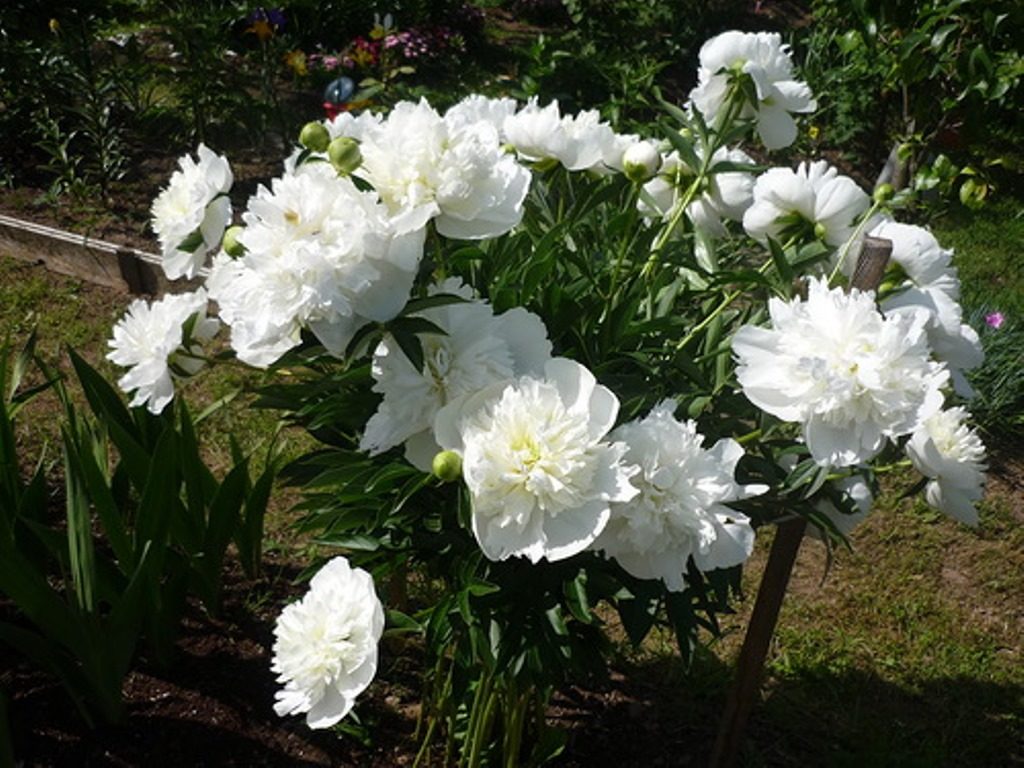Gardeners all over the world love and appreciate peonies. There are more than 5000 varieties of them. Only More than 500 varieties bloom in Russian gardens. The article proposes to consider one of the types of this plant - the Terry bomb peony.
Popular varieties
There are many varieties of this plant. But there are those that have long been loved by Russian gardeners for their beauty, endurance and unpretentiousness.
Red Charm
One of the favorites of Russian flower growers. It has huge red flowers that do not lose their brightness in the hottest sun. The diameter of the ball reaches 25 cm. The stems do not bend under the heavy caps of inflorescences.
Raspberry Sundae
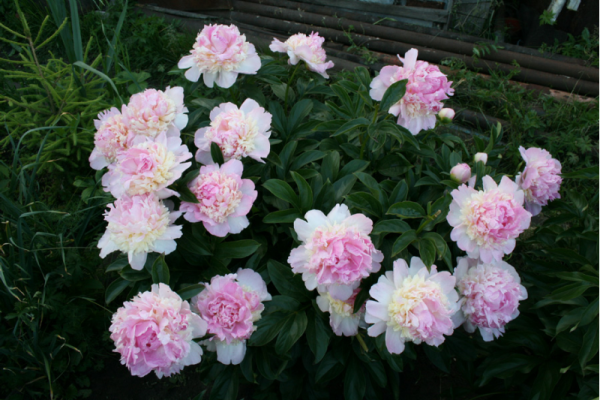
Bush with lush green shiny foliage. In the center it has a yellow-creamy color, followed by pale pink petals.. The aroma is rich. Flowering period is average.
Monsieur Julie Elie ( Monsieur Jules Elie)
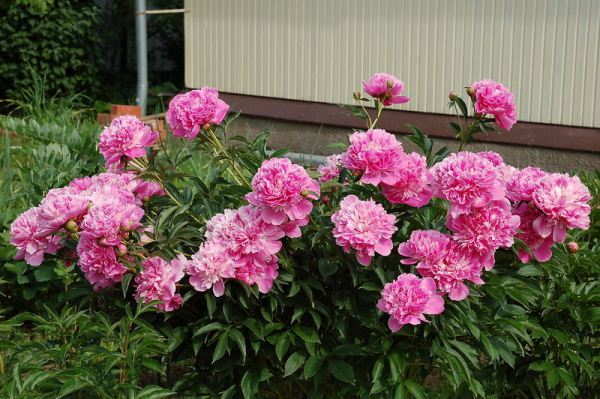
The bush grows up to 1 meter in height. Has a delicate color. Very fragrant.
Duchess de Nemours ( Duchesse de Nemours)

Interesting because its smell is very reminiscent of lily of the valley. The flowers are large and have a yellowish-green center.
BOB
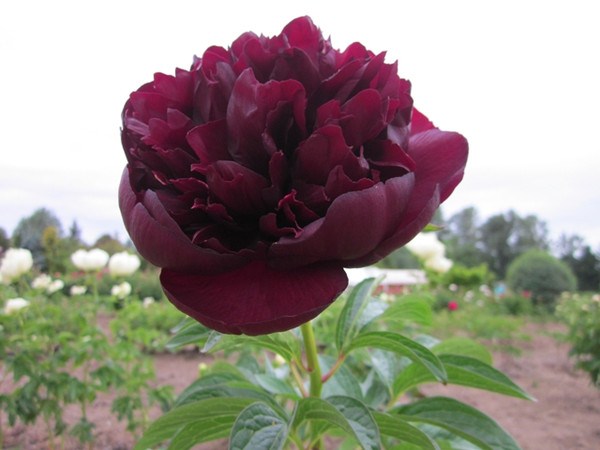
New gift US breeders, which is already loved by our flower growers. Interesting because has a dark cherry color. Diameter - 22 cm. Bush height 80 cm. Early deadline flowering.
Colonel Owen Cousins

Incredibly beautiful white flower. On the saucer of the lower petals there is a lace ball of the core. The height of the bush is 75 cm. The flowering period is average.
Pink Cameo ( Pink Cameo)
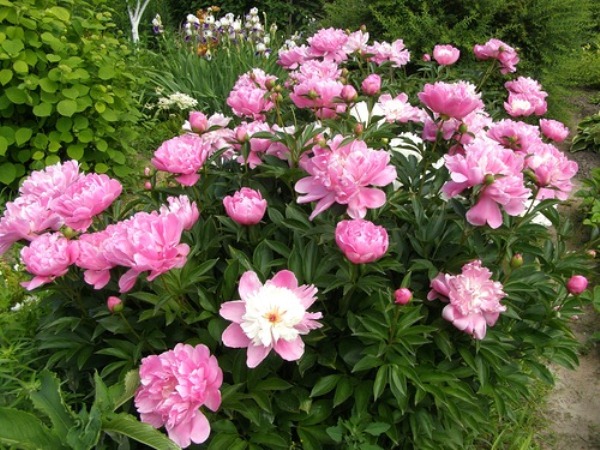
The flowers are creamy pink. Average – late date flowering. Plant height 80 cm, flower diameter 16 cm.
Alexandre Dumas ( Alexandre Dumas)
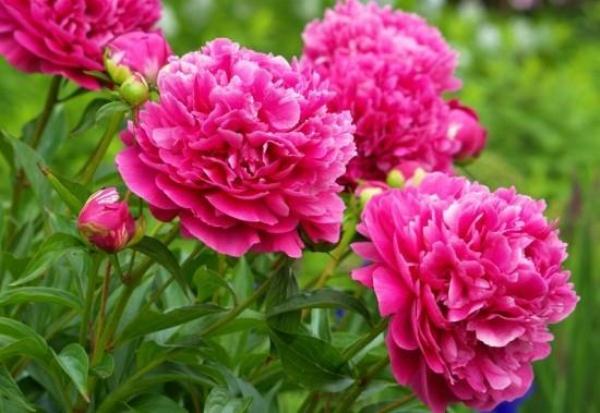
A very popular variety. Pink-lilac flowers, diameter 15 cm. The bush grows up to 90 cm.
In order to purchase a real varietal peony, you should contact specialized stores or the websites of flower companies. Otherwise, you can buy a flower that will not give you the desired color and shape.
Features of Terry Bomb Peony
This plant was named after the deity of the ancient Greeks - Paean. Paean healed the Olympian gods from illnesses. Most species are also “healers.” They are used in the treatment of diabetes, arthritis. They treat the kidneys and cardiovascular system. Used for poisoning, ulcers and varicose veins.
But you should be careful when using this plant as a medicine.
The dye contained in peony flowers (peonin) is poisonous!
Appearance
The appearance of the double bomb peony is good throughout the warm season. This species is a herbaceous perennial. The roots of the plant are tuberous and fleshy. Stems reach a height of up to 1 meter. The leaf has a dissected shape.
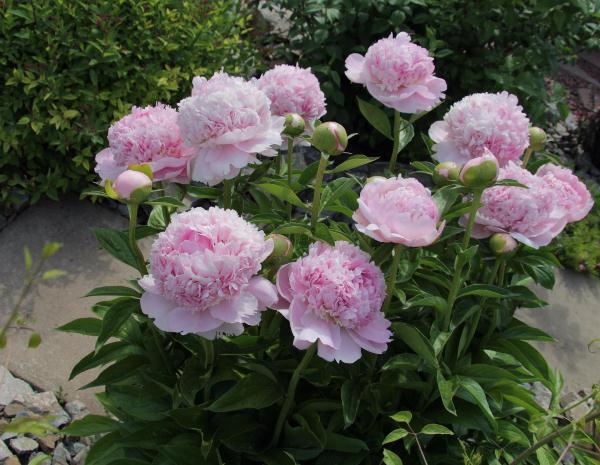
Flowers have strong doubleness. The saturation of the petals is so great that when fully bloomed, the flower looks like a ball or a bomb. It is because of this shape that this species received the name Terry bomb-shaped peony.
Color may vary.
Care
Regular care is required. Despite its beauty, it does not require much attention. When planted correctly, this garden worker will produce lush blooms every year.
Frost resistance
Frost resistance is excellent. In winter, even in cold regions, this plant does not freeze out without additional shelter. However, it is better to play it safe - trim the bushes and cover them.
Bloom
Blooms annually, occurs in different varieties at different times.
 All varieties of Terry peonies can be divided into certain groups depending on their flowering period
All varieties of Terry peonies can be divided into certain groups depending on their flowering period Based on when the plant blooms, peonies are divided into groups:
Peonies are planted only in August - early September. If the cutting appears in the spring, it should be planted in a spacious pot in order to transplant it to a permanent place in August.
Have you been imprisoned? We look after and feed
After the plant is planted, it requires abundant watering.
In the future, the plant does not require special care. however, watering, loosening, weed and pest control must be regular.
In the second year after planting, you should not expect vigorous flowering from the plant. The flower will begin to delight with caps of inflorescences by the third year. And the flowers will begin to bloom in May.
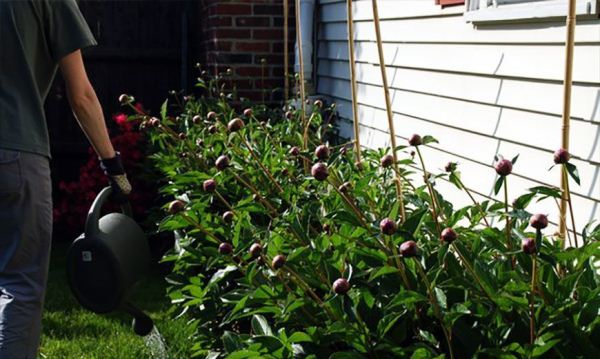
In the third year after planting, additional feeding will be required:
- 1 feeding- in the spring, after the snow melts. It should be fed with urea (10 g per bush).
- 2 feeding will be during budding.
- 3 feeding- at the beginning of flowering (nitrophoska, 1 tsp for each bush).
- 4 feeding- after flowering, 2 weeks later (add 1 tablespoon of superphosphate, 1 glass of ash).
It is better to give fertilizers in dissolved form.
Fertilizers should not fall on the neck of the bush.
Peonies in the garden
The function of the peony is to decorate the garden. But there are some other features too:
- if you plant flowers in a line, they will delimit the space of the site into zones;
- using this plant focus attention on the desired object(for example, peonies at the entrance to the gazebo);
- good as a 2nd tier(for example, low-growing plants are planted, and then a wall of hops. A middle tier is necessary);

- cover not very attractive places(if you plant them in front of the house, you can hide the not very decorative bottom of the house facade);
- great in quality path framing.
Plant peonies so that they become a real treat for the eyes.
Conclusion
In conclusion, I would like to note that peony is an unpretentious, hardy and amazingly beautiful plant. Due to its beauty, this flower does not require much effort from the grower; even a beginner can grow it. To him Warm climatic conditions are not required. In terms of care, it only requires watering, loosening and fertilizing. Therefore, he is simply obliged to settle in every garden, on every summer cottage and near every country house.
Plant a peony and it will exceed all your expectations.
Paeonia
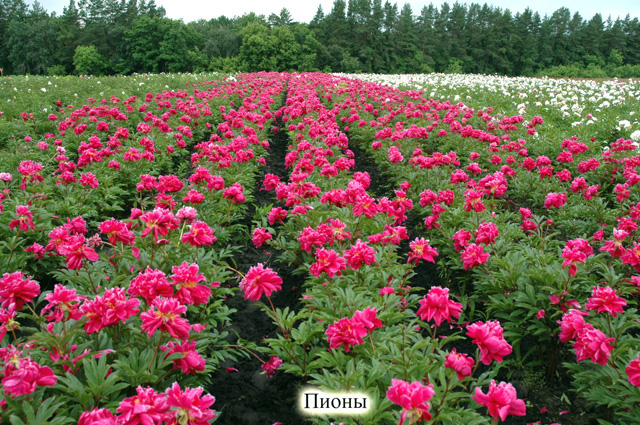 Herbaceous peonies
- plants up to 130 cm tall, with large
Herbaceous peonies
- plants up to 130 cm tall, with large 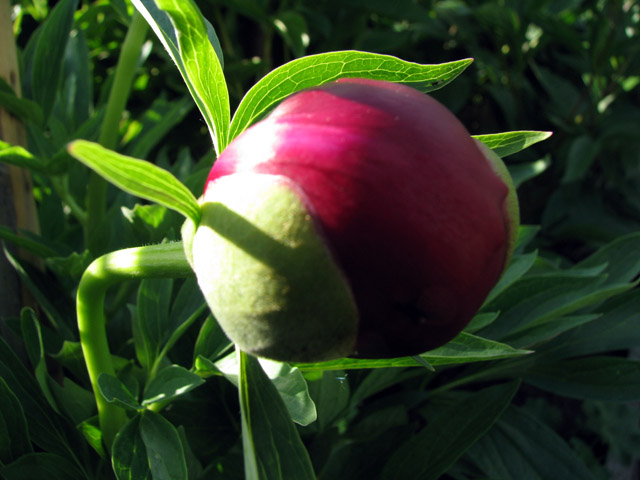 perennial, fleshy rhizomes and annual, herbaceous, well-leafed shoots.
perennial, fleshy rhizomes and annual, herbaceous, well-leafed shoots.
Leaves peony
large, trifoliate, very ornamental throughout the growing season.
Flowers herbaceous peony
bright, large, apical, single or several, double or non-double,  semi-double, beautifully cup-shaped, often with a strong aroma. Flower color herbaceous peony
- white, pink, red, less often - yellow.
semi-double, beautifully cup-shaped, often with a strong aroma. Flower color herbaceous peony
- white, pink, red, less often - yellow. 
Currently, about 5 thousand varieties are registered in the world herbaceous peony
, which originate primarily from two types - peony officinalis
And peony milkweed
.
There are over 500 cultivars in our country peony
. They differ in color, size and shape of flowers, flowering time, height and appearance of the bush.  Planting, replanting and dividing peonies
only possible in the fall. To herbaceous peonies
They grew and bloomed well in one place for many years, it is important to choose it correctly right away.
Planting, replanting and dividing peonies
only possible in the fall. To herbaceous peonies
They grew and bloomed well in one place for many years, it is important to choose it correctly right away. 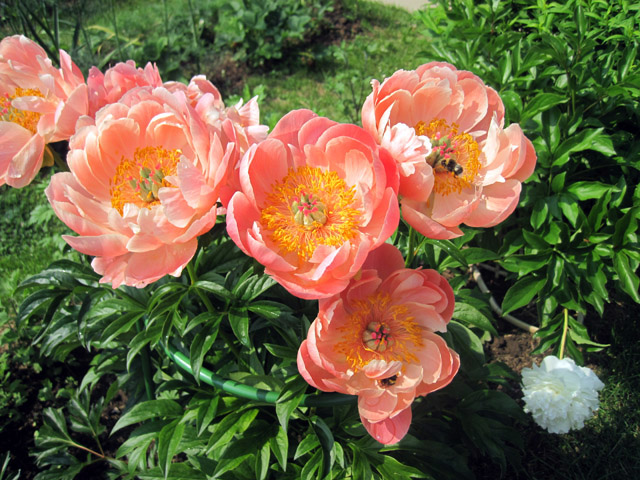 For varietal peonies
there must be a place open and sunny
, although some shading during midday hours is acceptable. In deep shadow peonies
grow but don't bloom.
For varietal peonies
there must be a place open and sunny
, although some shading during midday hours is acceptable. In deep shadow peonies
grow but don't bloom.
Feel great under the canopy of trees wild species of herbaceous peony
- marin root
, peony 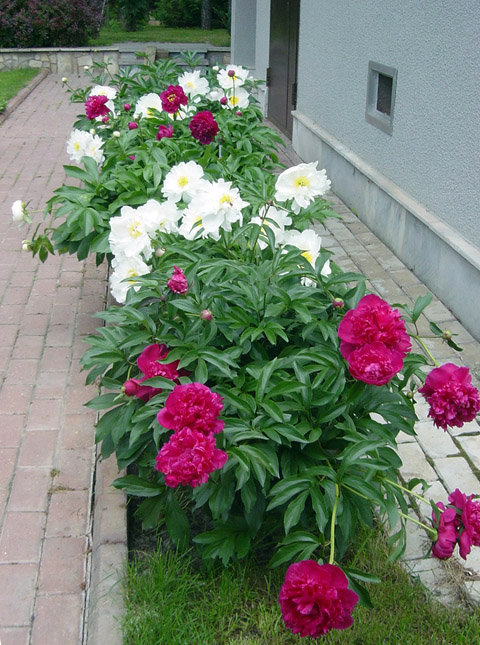 narrow-leaved
, Caucasian species and even milky peony
.
narrow-leaved
, Caucasian species and even milky peony
.
Peonies Can't stand getting wet!
Planted out peonies
in groups and individually, on lawns, along borders, paths and paths, in mixborders. To design a plot, you need to select varieties peonies
with a beautiful bush shape and bright flowers, with different flowering periods. For cutting, I recommend choosing profusely flowering ones. peonies
with a beautiful flower shape, fragrant.
In the company "YOUR FUTURE GARDEN" Future Garden You you can buy various types and herbaceous PEONY varieties (from 250 rubles per container):
Herbaceous peony "Sarah Bernhardt":
 Herbaceous peony Sarah Bernhardt.
Group Rosaceae
Herbaceous peony Sarah Bernhardt.
Group Rosaceae 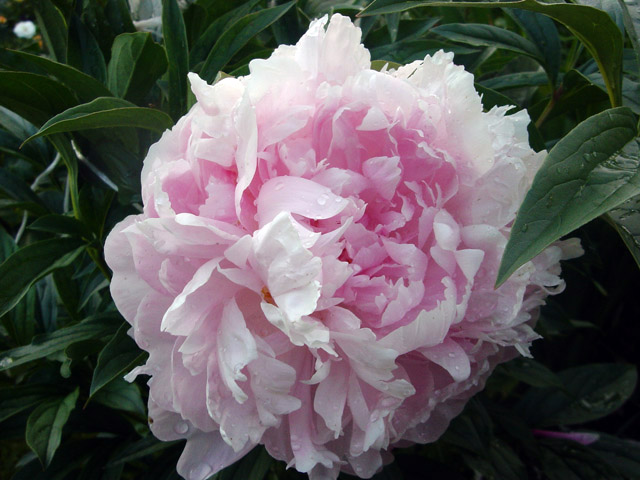 Peonies.
Peonies.
Lemoine, 1906, France.
The plant is 94-100 cm tall, the stems are straight, strong, the bush is semi-spreading, the flower is up to 16 cm in diameter, asexual, very double, pink. There are 3-4 large buds on the shoots. Blooms profusely in June for 12-13 days. Propagates well from cuttings. Recommended for all types of decoration.
Herbaceous peony "Sylvia":
 Herbaceous peony "Sylvia"
. Group of Crown Peonies.
Herbaceous peony "Sylvia"
. Group of Crown Peonies.
Krelagen, 1917. 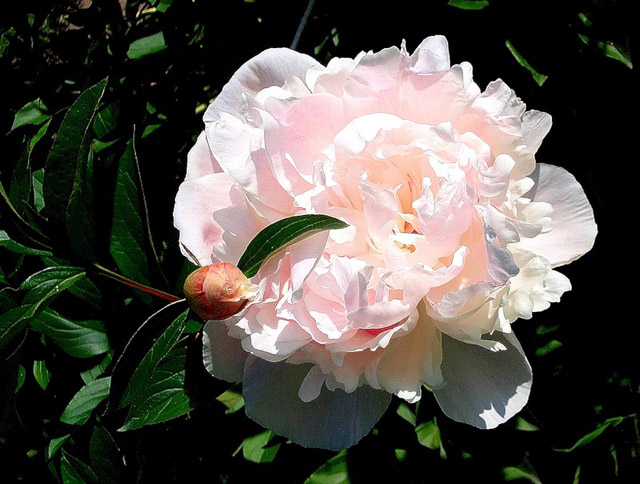
The plant is up to 80-90 cm tall, the stems are thin, weak, bend to the ground under the weight of the flowers, the bush is spreading, there are 2-3 lateral buds on the stems, the leaves are light green with reddish veins and edges, the flower is 11-13 cm in diameter, the outer the petals are wide, entire, white-pink, the inner ones are narrow, wavy, creamy-yellow, the crown is cream. It blooms in the first half of June for 10-12 days. Fragrant. Recommended for cutting.
Herbaceous peony "Duchesse de Nemours":
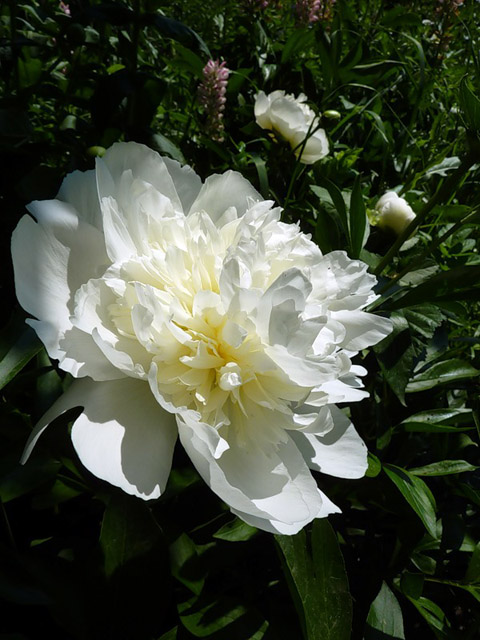 Herbaceous peony "Duchesse de Nemours"
Group
Herbaceous peony "Duchesse de Nemours"
Group 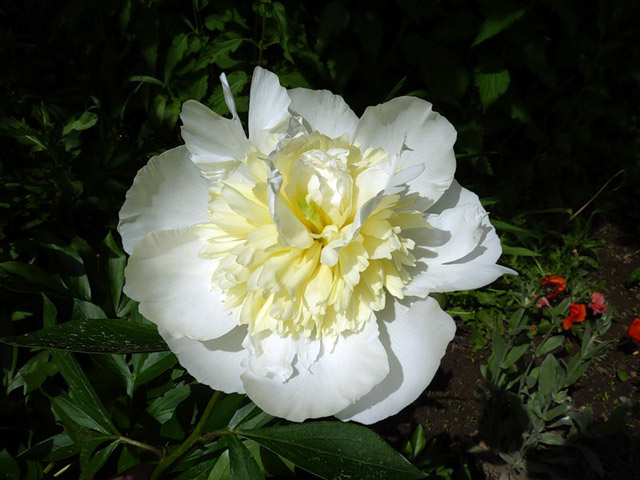 Crown Peonies.
Crown Peonies.
Kahlot, 1856, France.
The plant is up to 95 cm tall, the stems are straight, strong, the bush is compact, the flower is 12-13 cm in diameter, feminized, white with a cream center. There are 3-5 buds on the shoot. Blooms profusely in June for 10-12 days. Flowering duration is up to 7 days. Bears fruit. Recommended for single and group plantings, cutting.
Herbaceous peony "Nigricans":
 Herbaceous peony "Nigricans"
. Bush Peony "Nigricans"
- With
Herbaceous peony "Nigricans"
. Bush Peony "Nigricans"
- With 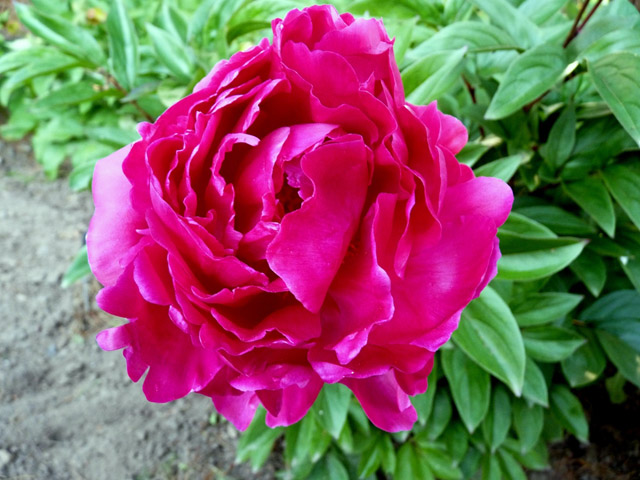 straight stems. The flowers are large, double, purple-carmine with a lilac tint. The beginning of flowering is later - the third ten days of June.
straight stems. The flowers are large, double, purple-carmine with a lilac tint. The beginning of flowering is later - the third ten days of June.
Herbaceous peony "Coral Supreme":
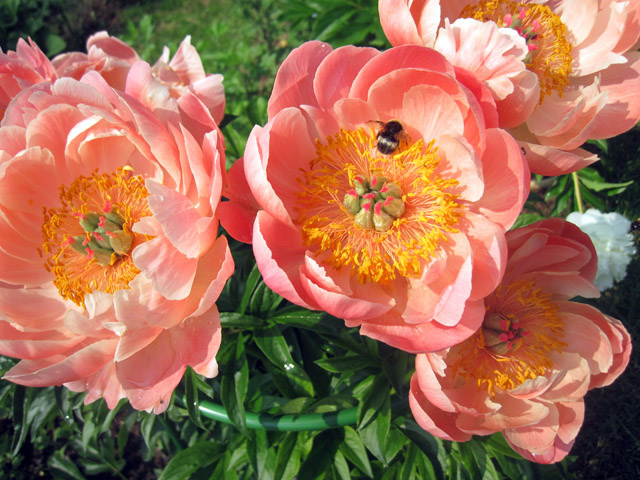 Herbaceous peony "Coral Supreme".
(Wissing, 1964, USA).
Herbaceous peony "Coral Supreme".
(Wissing, 1964, USA). 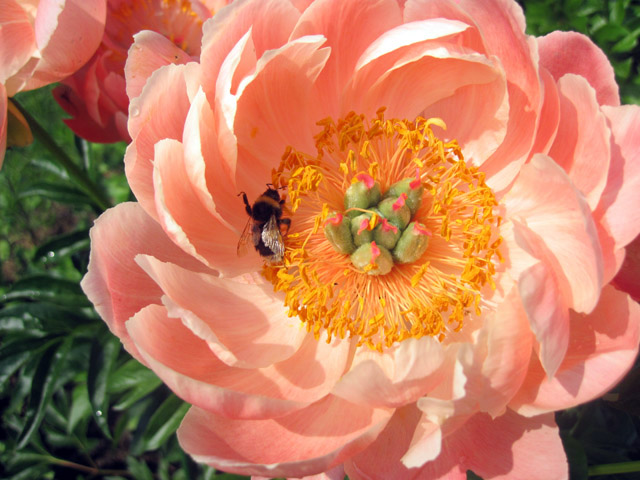 Interspecific hybrid.
Interspecific hybrid.
Flower peony "Coral Supreme"
-semi-double, bright coral pink. Flower diameter - 16 cm. Bush height - 90 cm. The smell is weak. Early flowering period.
There are many varieties. Duchesse De Nemours is considered the most popular among the classic varieties. Let's take a look at the features of this variety and find out what these flowers look like and how they should be grown.
Description of the peony variety "Duchess de Nemours"
First of all, it should be noted that the peony variety “Duchess de Nemours” belongs to the mid-late variety. It is a herbaceous perennial with powerful root tubers. Its double flowers have a large diameter compared to other varieties (15-20 cm) and beautiful shade, turning from snow-white with a greenish tint to pearl white. "Duchess" blooms on average from 10 to 20 days.
In addition, “Duchess de Nemours” is one of the varieties of peonies that have the strongest aroma - sweetish, reminiscent of the smell of lily of the valley. Peonies of this variety look great both in group plantings and in single ones. They last a long time when cut and are often used for combined bouquets. The bush of this peony itself, spreading and dense, reaches 1 m in height and is distinguished by abundant flowering. In addition, it grows quite quickly. Its openwork dark green leaves become crimson in autumn, which gives the “Duchess de Nemours” variety a special decorative appearance.
Growing peonies "Duchess de Nemours"
This variety is unpretentious to soil, frost-resistant, and does not require special care. It is permissible to fertilize the bushes once every few years, but peonies grow best in soil rich in nutrients. But “Duchess” does not like dense soils. It should also be said about the resistance of this variety to diseases - along with its beautiful appearance, this is one of its obvious advantages.
A flower bed with peonies should be located in a sunny and warm place. Duchesse De Nemours peonies are usually propagated by dividing the rhizomes. Varietal characteristics appear 2-3 years after transplantation.
Today we will talk about this beautiful flower, like the peony duchesse de nemours. This garden flower can be used for decorative purposes and will decorate any garden.
Description
A bush with white flowers about 16 cm in diameter grows up to 1 m high. It can compete with other garden plants in beauty and durability. Ranks first among peony varieties in sales in the Netherlands. Duchess is a late flowering variety. Its flowers are double. The outer petals of de Nemours are white, and the crown is closer to milky in color. Such heterogeneous coloring makes de Nemours original and attractive. Duchess is resistant to cutting, shade and frost.

It has very strong roots. For the winter, only very young bushes are covered, and in the future, shelter is no longer required. Duchess normally tolerates frost down to -20C. Duchess de Nemours also has a wonderful scent of lily of the valley. It is resistant to diseases, like other varieties of peonies, and is not susceptible to gray rot. Loves bright sunlight very much. Its lifespan is about 7-10 years.
How to propagate?
The main breeding option herbaceous peonies are a vegetative method. After thoroughly washing the roots and trimming shoots with leaves to a length of 7-8 cm, you can begin to separate the roots of an adult 3-4 year old bush into pieces.
This is best done by dividing the bush. We give you a brief description of this method.
- Holes for planting are dug at a distance of 0.6-0.7 m, since peony bushes are spreading.
- You need to add a little humus or compost, 50 g of superphosphate, bone meal to the soil, and you can also use mineral fertilizers.
- The usual hole size is 50x. In order for the plant to feel good and bloom, you should not make a hole that is too deep. If this does happen, at the end of summer you should dig up the peony and plant it in a new hole according to all the rules.
Grooming activities
Duchess de Nemours is an unpretentious peony. It needs to be watered based on the weather in the region. When it's hot, increase the intensity of watering. Remove weeds, loosen the soil - everything as usual. From the third year of life, the bush is fed with humus twice a season. That, perhaps, is all that Duchess de Nemours requires for himself.
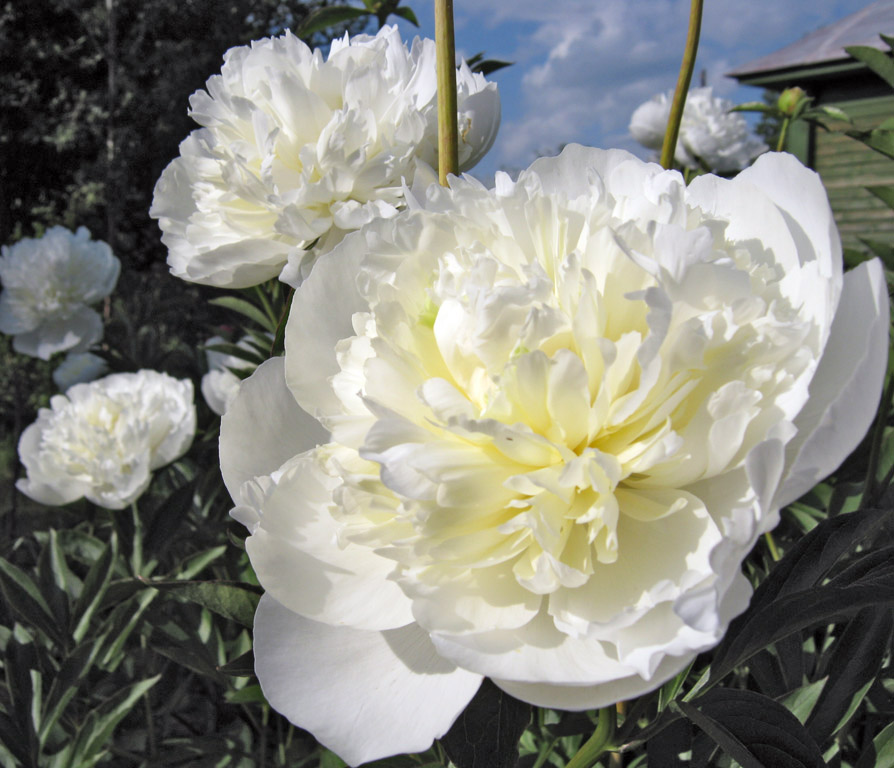
After cutting, the flower retains its fresh appearance for 2 weeks. Very beautiful both in a flowerbed and in a single planting. Not only the flowers themselves are beautiful, but also the dark green leaves with a slightly reddish tint. It can rightfully be called the best fragrant variety of peonies. For a century and a half it has been pleasing to the eye and has not lost its popularity. Elegant, light, not afraid of rain, frost, or wind. A completely unpretentious, but royal flower. It’s simply impossible to take your eyes off such beauty – one flower combines several different shades at once! This variety of peony takes its rightful place in landscape design. Will decorate any area, any flower bed or border.
Pests of peonies
The Duchess variety is practically not susceptible to diseases. For example, it is not affected by gray rot. Sometimes rust, brown spotting and ring mosaic may occur. For example, a measure to combat brown spot is as follows: pour 0.5 liters of 0.1% foundationazole into the base of the plant bush. 0.7% copper oxychloride can destroy rust. But the ring mosaic of leaves can only be prevented, for which Alirin is used.
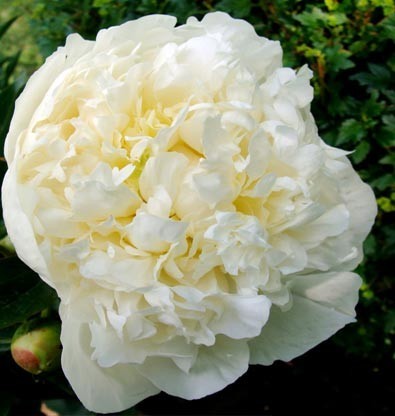
If peonies are affected by aphids, the drug Agrovertin and Fitoverm will be effective.
Peonies in landscape design
These beautiful, fragrant ornamental bushes do not leave anyone indifferent. In addition to white, there are pink, red varieties, yellow and other colors. They all smell pleasant, filling the space around them with a delicate aroma.
You can plant peonies with flowers such as poppies and irises. Also try to plant other types of peonies, for example, tree peonies, together with Duchess de Nemours. These flowers can literally transform appearance your site. Treat the planting of each plant on your site with soul and responsibility, and they will delight the eye.
To achieve a good aesthetic effect, select plants of the same height and plant them nearby. For bushes, use bush holders so that large, heavy flowers do not lie on the ground after rain.
Peonies can do a lot in landscape design. You can create interesting, simply magical compositions from these luxurious flowers. They create a great atmosphere on the site. Both tree and park varieties look beautiful. A combination of coral, white and red colors would be great. Try combining peonies with bluebells and daylilies. It is better not to plant peonies of different varieties nearby. Bush varieties look good against the backdrop of tall trees with a dense crown. These flowers look good planted along the fence.
The homeland of these beautiful flowers is China. In Chinese symbolism, the peony means beauty and wealth and is considered the imperial flower. And in our time, near Buddhist temples there is always a garden in which these flowers are presented in all their beauty and splendor of white, pink and purple shades. China especially loves tree varieties, which are not so widespread here.
We offer a selection of 10 stunningly beautiful and easy-to-care peonies with double inflorescences.
We bet the first association that comes to your mind when you hear the word “peony” is large spherical inflorescences with lush petals? This is exactly what terry peonies are.
A decorative bush of double peonies should not only give you beautiful and fragrant flowers, but also be unpretentious and not afraid of frost. We offer you a selection of such elite varieties in this article.
Bowl of Cream
Bowl of Cream– a spectacular milky-flowering peony. Its name means “bowl of cream,” and the color of the petals of the cup-shaped flower confirms this similarity. The inflorescences of this peony are whitish-cream, reminiscent of whipped cream in color.
Bowl of Cream winter-hardy, easy to care for, as a rule, does not require garter.
Henry Boxtos
Peony Henry Boxtos- a stunningly beautiful interspecific hybrid that has won a huge number of awards. Its huge inflorescences of a luxurious ruby hue can claim to be the main decoration of the garden.
The magnificent pink-shaped flowers of this peony look spectacular in bouquets and floral arrangements.
The plant can withstand winters when temperatures drop below –30°C. Peony loves good lighting, but can also feel comfortable in partial shade.
Duchess de Nemours
Duchess of Nemours (this is exactly what the name of the variety sounds like translated from French) is a peony beloved by flower growers for the last 150 years. This is one of the most famous varieties of terry peony.
Duchess de Nemours- a real handsome man. Its inflorescences are a snow-white ball about 20 cm in diameter. Large petals on the outside of the flower border smaller double petals in the center.
Peonies of this variety bloom magnificently for 1-1.5 weeks in late May - early June. Duchess de Nemours plants are unpretentious to growing conditions and can even withstand severe frosts.
Kansas
This variety of American selection has won many awards in its homeland. The bushes do not have any special care requirements, tolerate severe frosts, and do not require frequent watering or fertilizing.
Inflorescences Kansas spectacular dark crimson hue, they emit a wonderful aroma and do not crumble in the bouquet for a long time. The bushes of this peony do not need support.
Red Spider
Red Spider- an attractive low-growing peony hybrid from the Rock Garden group (rocky garden). It loves sandy, rocky, limestone soils, good sunlight and can withstand low temperatures.
This "red spider" is notable for its charming bright crimson inflorescences. Red Spider“lives” in bouquets for a long time, so it is ideal for cutting.
Red Charm
Red Charm(or “red charm”) is a catchy, beautiful, attention-grabbing variety of terry peonies. The diameter of the red bomb-shaped inflorescences exceeds 20 cm, so sometimes the bush needs a garter.
A pleasant feature of this plant is its shiny dark green leaves, which remain decorative until frost.
Rich aroma of peonies Red Charm attracts large numbers of butterflies and bees.
Rosella
Charming peony with large dark pink flowers. If you cut off the branches at the stage of unopened buds, the flowers will last at least a week.
Rosella It blooms quite luxuriantly from the end of May. Bushes of this variety are winter-hardy, unpretentious, and ideal for creating mixborders.
Sarah Bernhardt
Peonies of this variety, named after the famous French actress, are rightfully considered one of the most spectacular and fragrant. At the end of spring - beginning of summer, the bush is covered with large terry balls of a soft pink hue with small splashes of crimson color.
Peony Sarah Bernhardt winter-hardy, undemanding to soil type, needs moderate moisture and good drainage.
Festiva Maxima
Herbaceous peony varieties Festiva Maxima decorates European gardens since the century before last. The color of the petals is interesting: they are snow-white, in places with an elegant dark crimson edging.
At the peonies Festiva Maxima strong pleasant aroma, they stand well in bouquets. The bushes retain their beautiful appearance after flowering ends.
Shirley Temple
This variety of milky-flowering peony is named after the youngest Oscar winner. Shirley Temple– gentle and charming, like the actress herself who gave him her name. The peony of this variety is especially attractive for its color: on the pale pink bomb-shaped inflorescence, inclusions of crimson and yellowish-cream shades are visible.
Shirley Temple exudes a strong aroma, retains a fresh appearance for a long time after cutting, is winter-hardy, and is not picky in care.

